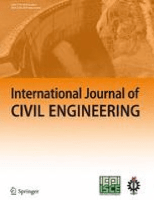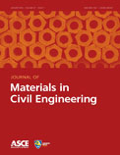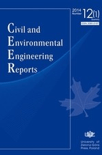
International Journal of Civil Engineering
Scope & Guideline
Transforming Challenges into Engineering Excellence
Introduction
Aims and Scopes
- Structural Engineering:
Research on the design, analysis, and performance of structures, including buildings, bridges, and tunnels, with a focus on materials, loads, and environmental effects. - Geotechnical Engineering:
Studies related to soil behavior, foundation design, and the interaction between soil and structures, addressing issues like liquefaction, slope stability, and earth pressure. - Transportation Engineering:
Exploration of transportation systems, including traffic management, road design, and the impact of infrastructure on mobility and safety. - Water Resources Engineering:
Research on hydraulic systems, water quality, and flood management, focusing on sustainable practices and the impact of climate change. - Construction Management and Technology:
Investigations into construction methods, project management, and the integration of new technologies and materials to improve efficiency and sustainability. - Environmental Engineering:
Studies aimed at addressing environmental challenges through innovative engineering solutions, including waste management, pollution control, and sustainable construction practices. - Material Science in Civil Engineering:
Research on innovative materials and their applications in civil engineering, including the use of recycled materials, composites, and performance under various conditions.
Trending and Emerging
- Sustainable and Resilient Infrastructure:
A growing emphasis on developing infrastructure that is sustainable and resilient against climate change and natural disasters, promoting the use of eco-friendly materials and design practices. - Advanced Computational Techniques:
An increase in the application of computational modeling, simulation, and artificial intelligence in civil engineering, enhancing predictive capabilities and optimizing designs. - Smart Materials and Structures:
Research into smart materials that respond to environmental changes, such as self-healing concrete and shape-memory alloys, is gaining traction for their potential to enhance structural performance. - Data-Driven Decision Making:
The integration of big data and machine learning techniques in civil engineering to improve project management, predictive maintenance, and performance evaluation of infrastructure. - Climate Adaptation Strategies:
Emerging research focused on adapting civil engineering practices to mitigate the impacts of climate change, including flood resilience and heat island effect mitigation. - Health Monitoring and Diagnostics:
A trend towards developing advanced health monitoring systems for existing structures using IoT and sensor technologies to ensure safety and longevity.
Declining or Waning
- Traditional Materials Research:
Research focusing solely on conventional materials like plain concrete and steel has seen a decline, as the field shifts towards more innovative materials and sustainable alternatives. - Static Analysis Methods:
The reliance on traditional static analysis methods for structural assessment is diminishing, with a growing emphasis on dynamic analysis and real-time monitoring techniques. - Local Case Studies:
While case studies remain important, there is a noticeable reduction in papers focused solely on localized issues without broader applicability or theoretical contributions. - Conventional Construction Techniques:
Research on traditional construction techniques is being overshadowed by studies exploring modern, technology-driven methodologies and automation in construction. - Single-Disciplinary Approaches:
There is a waning interest in research that does not integrate multiple disciplines, as interdisciplinary approaches are increasingly valued for addressing complex civil engineering challenges.
Similar Journals

JOURNAL OF MATERIALS IN CIVIL ENGINEERING
Pioneering Research for Sustainable ConstructionJOURNAL OF MATERIALS IN CIVIL ENGINEERING is a highly regarded publication within the field of civil engineering, published by the ASCE-American Society of Civil Engineers. This journal, which has been actively contributing to the discourse in building and construction materials since 1989, has established itself as a vital resource for researchers and practitioners alike, evidenced by its impressive Q1 rankings across multiple categories, including Building and Construction, Civil and Structural Engineering, Materials Science, and Mechanics of Materials as of 2023. With a strong focus on innovation and application in materials technology, it provides insights that are paramount for advancing practices in civil engineering. The journal's commitment to disseminating high-quality research is reflected in its exceptional standing within Scopus, where it ranks in the top quartile of its respective fields. Although not an open-access journal, it remains an essential platform for disseminating impactful research findings and fostering professional development in the materials science community. For more information or to explore the latest publications, researchers can access the journal through the ASCE library.

Infrastructures
Driving Progress in Civil and Structural EngineeringInfrastructures is a distinguished open-access journal, published by MDPI since 2016, dedicated to advancing the fields of engineering and construction through interdisciplinary research and critical insights. Based in Switzerland, it serves a global community of scholars and professionals, providing a platform for innovative studies that drive progress in Building and Construction, Civil and Structural Engineering, Computer Science Applications, Geotechnical Engineering and Engineering Geology, and various aspects of Materials Science. With an impressive impact factor and a positioning in the Q2 category across multiple engineering fields, the journal's robust ranking reflects its commitment to high-quality research, with notable Scopus rankings showcasing its significant contribution to academic discourse. Infrastructures not only facilitates open access to essential knowledge but also aims to bridge the gap between theory and practical application, making it an invaluable resource for researchers, industry professionals, and students alike.

Electronic Journal of the Faculty of Civil Engineering Osijek-e-GFOS
Exploring New Frontiers in Civil Engineering ExcellenceWelcome to the Electronic Journal of the Faculty of Civil Engineering Osijek-e-GFOS, a prominent platform dedicated to the dissemination of innovative research in the field of civil engineering. Published by the University of Osijek, this Open Access journal has been accessible to the global academic community since 2010, facilitating the sharing of knowledge and advancements without financial barriers. With an E-ISSN of 1847-8948, the journal aims to cover a broad scope of civil engineering disciplines, including structural engineering, geotechnics, environmental engineering, and construction management, among others. It serves as a crucial resource for researchers, professionals, and students, providing them with insightful articles and studies that contribute to the development of best practices in the field. By promoting open collaboration and knowledge sharing, the Electronic Journal of the Faculty of Civil Engineering Osijek-e-GFOS stands as a testament to the commitment of the University of Osijek to enhance the field of civil engineering through impactful research and educational outreach.

KSCE Journal of Civil Engineering
Championing Quality Research in Civil EngineeringKSCE Journal of Civil Engineering is a prestigious international publication dedicated to advancing the field of civil engineering. Established by the Korean Society of Civil Engineers (KSCE), this journal serves as a vital platform for high-quality research in the discipline, showcasing innovative methodologies, case studies, and critical analyses pertinent to civil and structural engineering. With an impact factor placing it in the Q2 category of civil engineering journals for 2023 and a solid Scopus rank of #141 out of 379, it reflects the significant contributions of its authors and the growing recognition of its published works. KSCE Journal of Civil Engineering, based in Germany and easily accessible to the global research community, is committed to disseminating knowledge with rigor and integrity, encouraging both emerging scholars and seasoned experts to contribute to the evolving discourse in civil engineering. With a convergence period from 2009 to 2024, the journal continues to uphold its mission of fostering innovation and excellence in engineering practice.

Civil and Environmental Engineering Reports
Unlocking insights for a greener tomorrow in engineering.Civil and Environmental Engineering Reports is a prestigious open access journal published by UNIV ZIELONA GORA, dedicated to advancing research in the dynamic fields of civil and environmental engineering. With its ISSN 2080-5187 and E-ISSN 2450-8594, the journal aims to disseminate innovative studies, methodologies, and practical applications that address contemporary challenges in these disciplines. Since its establishment in 2014 as an open access platform, it has emerged as a vital resource for researchers, professionals, and students alike, enabling free access to high-quality research findings. Situated at Licealna 9, Zielona Góra 65-417, Poland, the journal strives to foster collaboration and knowledge exchange within the global engineering community, making it an essential reading for anyone invested in civil and environmental engineering advancements.

Innovative Infrastructure Solutions
Connecting Innovators for a Greener Infrastructure Tomorrow.Innovative Infrastructure Solutions is a leading academic journal published by Springer International Publishing AG, focusing on pioneering advancements in the fields of building and construction, civil and structural engineering, and environmental engineering. With an impact factor that reflects its significant role in the academic community, this journal serves as a vital platform for researchers, professionals, and students to disseminate groundbreaking studies and novel methodologies spanning diverse engineering disciplines. Since its inception in 2016, Innovative Infrastructure Solutions has steadily positioned itself within the Q2 category across several fields, including geotechnical engineering and engineering geology, as recognized in the 2023 quartiles. This reputable journal, accessible from Switzerland, not only emphasizes collaboration and knowledge exchange but also empowers innovators in infrastructure development globally. Whether you're contributing to a research project or seeking the latest findings, Innovative Infrastructure Solutions remains essential for anyone invested in advancing sustainable infrastructure solutions.

Electronic Journal of Structural Engineering
Elevating Engineering Standards through Open Access ScholarshipThe Electronic Journal of Structural Engineering (ISSN: 1443-9255), published by EJSE INT LTD, serves as a vital platform for disseminating innovative research and developments in the field of structural engineering. Since its inception in 2001, the journal has evolved to embrace an Open Access model starting in 2022, ensuring that cutting-edge findings are freely accessible to researchers, professionals, and students worldwide. Housed within the reputable Department of Infrastructure Engineering at the University of Melbourne, Australia, the journal focuses on a wide range of topics related to civil and structural engineering, positioning itself within the Q4 category on the 2023 Scopus rankings. While its H-index and detailed scope data are currently unavailable, the journal's commitment to quality research is evident through its continuous publication and engagement with the global academic community. With significant implications for contemporary engineering practices, The Electronic Journal of Structural Engineering not only fosters scholarly discourse but also encourages practical applications of structural engineering advancements.

Turkish Journal of Civil Engineering
Connecting Scholars to Shape the Built EnvironmentWelcome to the Turkish Journal of Civil Engineering, a pioneering publication under the auspices of the TURKISH CHAMBER OF CIVIL ENGINEERS, dedicated to advancing the field of civil engineering and construction. With a focus on cutting-edge research and innovative practices, this journal seeks to provide a platform for scholars, professionals, and students to share their findings and insights within the sphere of civil and structural engineering. The journal is committed to open access, ensuring that research is readily available to a global audience. As it embarks on its journey from 2023 to 2024, it aims to enhance its reputation as a vital resource within the academic community, currently ranking in the 40th percentile for Building and Construction Engineering and 32nd for Civil and Structural Engineering in Scopus. We encourage contributions that push the boundaries of engineering knowledge, fostering collaboration and progress in this essential field.

Transportation Infrastructure Geotechnology
Advancing the Future of Transportation Infrastructure.Transportation Infrastructure Geotechnology, an esteemed journal published by SpringerNature, serves as a vital platform in the fields of Civil and Structural Engineering, Environmental Engineering, Geotechnical Engineering, and Transportation. Established in 2014 and spanning a decade of significant scientific discourse, this journal has gained recognition for its robust contribution to the understanding of the interplay between geotechnical processes and transportation infrastructure. With an impactful Q2 ranking in multiple categories—including Civil and Structural Engineering and Environmental Engineering—it emphasizes innovative research and practical applications globally. Researchers and professionals can explore critical topics that influence infrastructure sustainability, safety, and efficiency. Although it operates under a subscription model, its affiliation with SpringerNature ensures rigorous peer-review and high-quality publications, making it an indispensable resource for academics and industry experts alike.

Civil Engineering Infrastructures Journal-CEIJ
Building bridges between research and practice in civil engineering.Civil Engineering Infrastructures Journal (CEIJ), published by the University of Tehran, College of Engineering, is a premier platform dedicated to advancing the field of civil and structural engineering. With an ISSN of 2322-2093 and an E-ISSN of 2423-6691, CEIJ has been an Open Access journal since 2013, ensuring that critical research is accessible to a global audience. While it currently holds a Q4 category ranking in Civil and Structural Engineering as per the 2023 quartiles, the journal is committed to enhancing its reputation and impact within the academic community. Researchers, professionals, and students will find valuable insights in its compelling articles, which cover a wide array of topics pertinent to civil engineering infrastructures. The journal aims to foster innovative ideas and solutions that address contemporary challenges in the industry. As a publication rooted in Iran but reaching an international readership, CEIJ serves as a significant conduit for disseminating impactful research in the ever-evolving landscape of civil engineering.